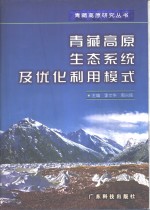

青藏高原生态系统及优化利用模式PDF电子书下载
- 电子书积分:14 积分如何计算积分?
- 作 者:李文华,周兴民主编
- 出 版 社:广州:广东科技出版社
- 出版年份:1998
- ISBN:7535919456
- 页数:422 页
Chapter 1 Ecological Characteristics and Effects of Natural Environments in Qinghai-Xizang(Tibetan)Plateau 1
第一章 青藏高原自然生态环境特征与生态效应 1
第一节 地质环境的演变与生态系统的形成 3
1.Geological evolution and ecosystem formation 3
第二节 地貌环境特征与生态系统的空间格局 8
2.Geomorphological characteristics and spatial patterns of ecosystems 8
第三节 气候环境的复杂性与生态系统的分布 11
3.Climatological complexity and ecosystem distribution 11
第四节 土壤环境与生态系统 15
4.Soil condition and ecosystem 15
References 18
参考文献 18
Chapter 2 Ecosystem Distribution Pattern and its Relation to Hydro-thermal Factors in Qinghai-xizang (Tibetan)Plateau 19
第二章 青藏高原生态系统分布规律及其与水热因子的关系 19
第一节 生态系统的植物区系特征 21
1.Flora characteristics of the ecosystems 21
第二节 生态系统的类型和特点 28
2.Ecosystem types and features 28
第三节 生态系统分布与水热条件的关系 46
3.Ecosystem distribution and its relation to hydro-thermal conditions 46
第四节 生态系统的潜在分布 55
4.Potential distribution of ecosystems 55
附录 青藏高原生态系统目录 58
Appendix list of ecosystems in Tibetan Plateau 58
参考文献 67
References 67
第三章 青藏高原主要生态系统的结构与演替 69
Chapter 3 Structure and Succession of Major Ecosystems in Qinghai-Xizang(Tibetan)Plateau 69
1.Structure and succession of forest ecosystem in Gongga Mountain 71
第一节 贡嘎山地区森林生态系统的结构与演替 71
2.Structure, function and succession of Alpine Meadow ecosystem 123
第二节 高寒草甸生态系统的结构、功能与演替 123
References 180
参考文献 180
Chapter 4 Biomass and Productivity of Ecosystems in Qinghai-Xizang(Tibetan)Plateau 183
第四章 青藏高原生态系统生物生产量 183
1.Summary of biomass and productivity research 185
第一节 生物生产量研究综述 185
2.Biomass and productivity of forest ecosystem 188
第二节 森林生态系统生物生产量 188
3.Biomass and productivity of Alpine Meadow ecosystem 203
第三节 高寒草甸生态系统生物生产量 203
4.Biomass and productivity of agricultural ecosystem 234
第四节 农田生态系统生物生产量 234
5.Comparison on biomass and productivity among the major ecosystems 244
第五节 主要生态系统生物生产量的比较 244
6.Comparison on biomass and productivity among the major ecosystems between Tibetan Plateau and the whole country 248
第六节 主要生态系统生物生产量与全国同类型的比较 248
7.Estimation of the total biomass and potential distribution of net primary productivity 250
第七节 生物总产量的估算与净初级生产量的潜在分布 250
References 268
参考文献 268
Chapter 5 Physiological Characteristics and Adaptive Mechanism of Plant Populations in Qinghai-Xizang(Tibetan)Plateau 271
第五章 青藏高原植物种群的生理特征及适应机理 271
1.Photosynthetic production and adaptive characteristics of eco-physiology for plant populations of Alpine Meadow ecosystem 274
第一节 高寒草甸生态系统光合生产及植物种群生理生态适应特征 274
2.Adaptive characteristics of eco-physiology for crops of agricultrual ecosystem 292
第二节 农田生态系统作物生理生态适应特征 292
3.Adaptive characteristics of eco-physiology for trees of forest ecosystem 304
第三节 森林生态系统林木生理生态适应特征 304
Reference 312
参考文献 312
Chapter 6 Optimal Models of Sustainable Uses of Ecosystems in Qinghai-Xizang(Tibetan)Plateau 315
第六章 青藏高原生态系统持续利用的优化模式 315
1.Sustainable use and protection of forest ecosystem 317
第一节 森林生态系统的持续利用与保护 317
2.Optimal production model and sustainable development of livestock farming in grassland ecosystem 345
第二节 草地畜牧业优化生产模式与可持续发展 345
3.Optimal model of farming ecosystem 362
第三节 农田生态系统的优化模式 362
Reference 380
参考文献 380
The Chinese and Latin Terms of Plant Species 383
植物拉丁文名、中文名对照 383
The Latin and Chinese Terms of Plant Species 403
植物中文名、拉丁文名对照 403
- 《家畜百宝 猪、牛、羊、鸡的综合利用》山西省商业厅组织技术处编著 1959
- 《北京生态环境保护》《北京环境保护丛书》编委会编著 2018
- 《你好,生态环境部!》生态环境部编 2019
- 《生态文化建设的社会机制研究》阮晓莺著 2019
- 《飞跃高原》李伟责任编辑;肖辉跃 2019
- 《长江口物理、化学与生态环境调查图集》于非 2019
- 《钢渣梯级利用技术》徐国平,黄毅,程慧高,万迎峰,林路 2016
- 《中国退役动力电池循环利用技术与产业发展报告》中国科学院过程工程研究所,资源与环境安全战略研究中心,中国物资再生协会编著 2019
- 《中国生态系统定位观测与研究数据集 森林生态系统卷 云南西双版纳》邓晓保·唐建维 2010
- 《一带一路非洲东北部区生态环境遥感监测》俞乐 2019
- 《中国十大出版家》王震,贺越明著 1991
- 《近代民营出版机构的英语函授教育 以“商务、中华、开明”函授学校为个案 1915年-1946年版》丁伟 2017
- 《科技语篇翻译教程》雷晓峰,李静主编 2020
- 《二十世纪广东包装设计史》王娟著 2019
- 《国之重器出版工程 云化虚拟现实技术与应用》熊华平 2019
- 《新闻出版博物馆 总第33期》新闻出版博物馆 2018
- 《上海市订购外国和港台科技期刊联合目录 1983 上》上海科学技术情报研究所 1983
- 《生物科技、医学与法律》齐延平,安·玛丽·杜盖著 2018
- 《科技新闻英语 英汉互译精选》郑佩芸主编;吴越,郭亮,毛隽副主编 2019
- 《科技法教程》李功国著 1993
